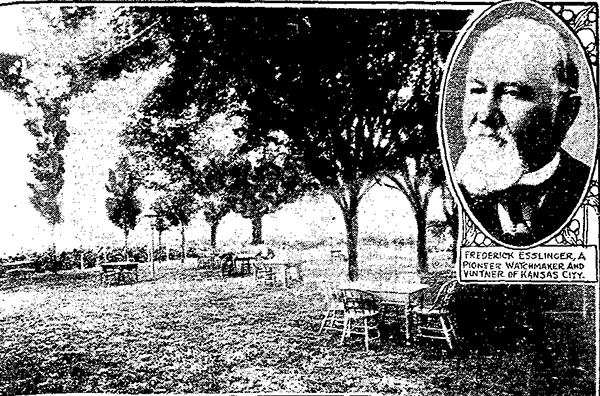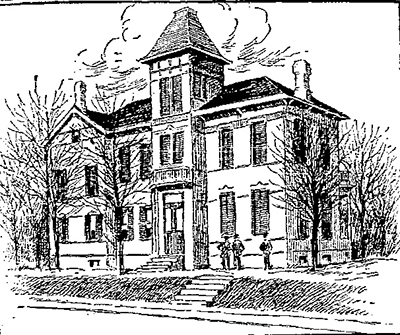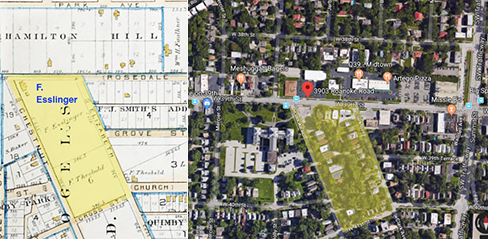
In the late 1800s, a popular entertainment site at Thirty-Ninth and Roanoke was called one of the most beautiful spots in Kansas City. For many years, German immigrant Frederick Esslinger’s house, vineyards, and wine garden were popular destinations for many Westport and Kansas City residents. After the wine garden was closed around 1900 and the house was razed, the neighborhood quickly filled in with the homes that still stand there today.
As part of our Uncovering History Project, the Midtown KC Post is examining each block in Midtown. A set of 1940 tax assessment photos is available for many blocks.
The wine garden was one of the most popular resorts hereabouts, according to one person who frequented Esslingers after it opened in 1876. “Many a grandpa and grandma of young Kansas City went there to spoon under the trees, in the dim light of the moon and stars, for there were no electric lights in the palmy days of Esslinger’s wine garden,” Mary Firth told the Kansas City Star in 1893.

Esslinger’s house stood at the southeast corner of 39th and Roanoke.
“Situated as it is on a high eminence, affording fine scenery, and having an abundance of beautiful shade trees covering a perfectly kept lawn, there is no more delightful spot about Kansas City. In the neat clubhouse, there is a splendid dance hall where private parties can come out and enjoy themselves in the cool of the evening. Mr. F. Esslinger, a pioneer of winemakers in the city, assisted by his son Edward, has taken great pains to make his cozy nook attractive to visitors.”
Esslinger’s wine garden was not the only one in the Midtown area, but the level of civility found at these drinking spots may have varied. Like several others who described the area, Firth took pains to point out that Esslinger’s did not cater to wild visitors.
“Mr. Esslinger has gained a reputation for keeping a strictly first-class garden, and one has no fear of meeting the rough element that frequents some public places than in one’s own home.”
Another local resident shared his memories in 1933 in the Star.
“On the entire length of the west side was a beautiful flower and shrub garden traversed with gravel walks. Near the northwest corner was a large house with a deep cellar, arched in with stone; part of this was walled off with separate double entrances, and there was kept a large stock of imported Swiss cheese (American imitations were then unknown). For use, each cheese was quartered, filled with excellent Riesling wine made on the premises, covered for days with cloths soaked in the same wine, and then served with the excellent rye or twisted Vienna bread baked in Esslinger’s own large ovens.”
Frederick Esslinger was born in Wurttemberg, Germany, in 1819. There, he attended school and apprenticed to a watchmaker. He came to the United States in 1850 and to Westport the following year, running a watchmaking and jewelry store in what is now downtown Kansas City. According to his son Ernest, who helped his father run the resort, he opened the wine garden on land where the family lived in 1876.
“We had tables out here under the trees, and the best people from Kansas City and Westport used to come here. It was a great sight, in the evenings, to see the elite of Kansas City gathered under the trees sipping their wines and being all the better for it.”
“Good wine, such as we had then, had a mighty influence in promoting a fine social intercourse. Family and neighborly groups would sit together here and have a jolly time, such as you never see today. Never any rough conduct, nobody drunk, but everyone feeling sociable and happy.”
Ernest recalled that Westport was growing and by the turn of the century, the piece of land was too valuable a spot for a wine garden. The Esslinger heirs divided it up and closed the wine garden in 1904. The Esslinger house remained on the site, however, until 1933.
For many years, a rumor persisted that Frederick Esslinger had buried treasure under the house. Some told the tale that Esslinger had buried a vast sum of gold when Quantrill’s guerillas were roaming the area before the Civil War. In 1933, when the home was being torn down, Ernest revealed the truth – he had been there when his father buried two bottles of wine and a note, nothing more. The note told the story of his life. The wine had turned to vinegar.

Sources: Westport’s Old Wine Garden Yields its “Buried Treasure,” Kansas City Star Oct. 22, 1933; “An Ideal Place, Kansas City Star, June 30, 1893, page 3.